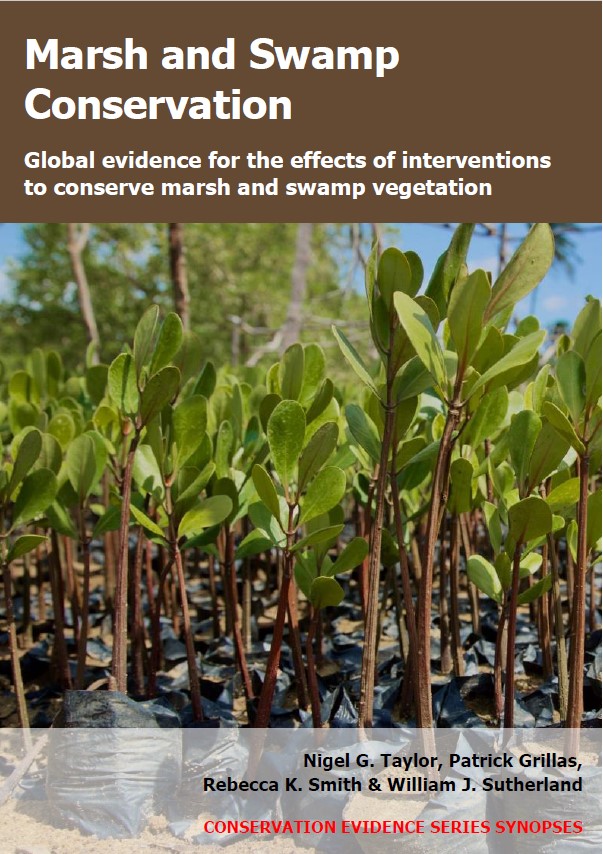Reduce frequency of vegetation harvest: freshwater marshes
-
Overall effectiveness category Likely to be beneficial
-
Number of studies: 3
View assessment score
Hide assessment score
How is the evidence assessed?
-
Effectiveness
50% -
Certainty
43% -
Harms
0%
Study locations
Supporting evidence from individual studies
A replicated, paired, controlled study in 1980–1981 in two artificial water treatment marshes dominated by cattails Typha spp. in Michigan, USA (Ulrich & Burton 1984) reported that harvesting cattail less frequently during one summer increased its biomass the following summer. Statistical significance was not assessed. Nine months after the last harvest, cattail biomass was 390 g/m2 in plots harvested every six weeks and 190 g/m2 in plots harvested every three weeks. There was a similar but less extreme pattern one year after the last harvest: cattail biomass was 760 g/m2 in plots harvested every six weeks and 600 g/m2 in plots harvested every three weeks. At both times, cattail biomass in unharvested plots was 620 g/m2. Methods: In June 1980, nine plots were established in each of two cattail-dominated marshes. Over 12 weeks, six plots (three plots/marsh) were cut every six weeks and six plots (three plots/marsh) were cut every three weeks. Cuttings were removed. The remaining six plots remained unharvested. In June and August 1981, above-ground cattail biomass was collected from each plot, then dried and weighed.
Study and other actions testedA replicated, paired, controlled, before-and-after study in 1986–1988 in five wet grasslands in Belgium (Dumortier et al. 1996) reported that harvesting plots once per year increased plant species richness and sometimes increased plant biomass, whilst harvesting twice per year increased plant species richness and reduced plant biomass. Statistical significance was not assessed. Over two years, plant species richness increased whether plots were harvested once per year (July: from 15 to 18 species/6 m2; October: from 19 to 20 species/6 m2) or twice per year (July and October: from 17 to 19 species/6 m2). Total above-ground biomass (including litter) increased in plots harvested in July (from 460 to 490 g/m2), but declined in plots harvested in October (from 730 to 480 g/m2) or July and October (from 660 to 630 g/m2). The study also included some data on the abundance of individual plant species under each harvesting regime (see original paper). Methods: In spring 1986, three 7 x 7 m plots were established in each of five adjacent wet grasslands (mown annually for the previous 10 years). From 1986, five plots (one plot/grassland) were mown in July, five were mown in October, and five were mown in July and October. Cuttings were removed. Plant species were recorded each summer between 1986 and 1988. Biomass was cut and collected from five 30 x 30 cm quadrats/plot/year, immediately before the first harvest (so not at the same time in all plots), then dried and weighed.
Study and other actions testedA paired, controlled, before-and-after study in 2000–2002 in two lakeshore reedbeds in northern Italy (Fogli et al. 2014) found that plots harvested once or twice each year supported similar common reed Phragmites australis biomass after two years. In both reedbeds, above-ground reed biomass was statistically similar in plots harvested once each year (in winter; 625–1,751 g/m2) and plots harvested twice each year (in summer and winter; 370–1,153 g/m2). Before harvesting, reed biomass was statistically similar in plots destined for each treatment (477–668 g/m2). Methods: In July 2000, a pair of 10 x 10 m plots was established in each of two reedbeds on the shore of Lago di Aslerio. From summer 2000, one plot/reedbed was mown once each year (August 2000 and 2001), one plot/reedbed was mown twice each year (February 2001 and 2002, plus August mowing). Cuttings were removed. The reedbeds had been historically harvested in winter (and sometimes in summer), but not for >30 years. Above-ground biomass was calculated from counts and measurements of reed shoots from three 1-m2 quadrats/plot, before intervention (July 2000) and two years later (July 2002).
Study and other actions tested
Where has this evidence come from?
List of journals searched by synopsis
All the journals searched for all synopses
This Action forms part of the Action Synopsis:
Marsh and Swamp Conservation
Marsh and Swamp Conservation - Published 2021
Marsh and Swamp Synopsis





)_2023.JPG)














